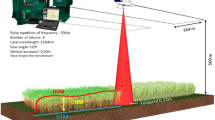Abstract
The continuous growth of agricultural production requires efficient strategies to manage the cultivation activities and ensure a high-quality standard for the food products. In this regard, the increased circulation of pathogens, also exacerbated by the consequences of climate change, represents a threat for environmental and agricultural assets. By the way of example, in recent years, the Xylella fastidiosa (Xf) bacterium has caused significant damage to the olive growing in the Apulia region, located in the south of Italy, with a consequent relevant economic impact. Geomatic methodologies for the acquisition and processing of ground spatial data can play a crucial role in the prompt identification of the effects of potentially harmful phenomena, such as Xf is, thus helping to develop effective countermeasures. This work presents the results of the analysis of a high-resolution three-dimensional dataset acquired with a Terrestrial Laser Scanner, which is generally used to reconstruct the shape of objects and structures. In this work, the intensity parameter associated to the point cloud has been investigated to infer information on the progression of the plant disease on a set of olive trees located in the Salento peninsula (Italy). These preliminary results could constitute the basis to design a strategy useful to monitor the effects of the spreading of Xf on medium-scale areas.
Access this chapter
Tax calculation will be finalised at checkout
Purchases are for personal use only
Similar content being viewed by others
References
Ciervo, M., Scortichini, M.: A decade of monitoring surveys for <scp> Xylella fastidiosa </scp> subsp. pauca in olive groves in Apulia (Italy) reveals a low incidence of the bacterium in the demarcated areas. J. Phytopathol. 172 (2024). https://doi.org/10.1111/jph.13272
Ciervo, M.: Il disseccamento degli olivi in Puglia, evidenze, contraddizioni, anomalie, scenari. Società Geografica Italiana (2020)
Martelli, G.P.: Il disseccamento rapido dell’olivo: stato delle conoscenze
Gualano, S., Tarantino, E., Santoro, F., Valentini, F., Dongiovanni, N., Maria D’onghia, A.: ASITA 2014 Analisi assistita da immagini aeree ad elevata risoluzione geometrica per il riconoscimento del Complesso del Disseccamento Rapido dell’Olivo associato al batterio Xylella fastidiosa in Puglia
Husin, N.A., Khairunniza-Bejo, S., Abdullah, A.F., Kassim, M.S.M., Ahmad, D., Aziz, M.H.A.: Classification of basal stem rot disease in oil palm plantations using terrestrial laser scanning data and machine learning. Agronomy 10, (2020). https://doi.org/10.3390/agronomy10111624
Zhu, X., Wang, T., Darvishzadeh, R., Skidmore, A.K., Niemann, K.O.: 3D leaf water content mapping using terrestrial laser scanner backscatter intensity with radiometric correction. ISPRS J. Photogramm. Remote Sens. 110, 14–23 (2015). https://doi.org/10.1016/J.ISPRSJPRS.2015.10.001
Baiocchi, V., et al.: First geomatic restitution of the sinkhole known as ‘Pozzo del Merro’ (Italy), with the integration and comparison of ‘classic’ and innovative geomatic techniques. Environ. Earth Sci. 77 (2018). https://doi.org/10.1007/s12665-018-7244-6
Liang, X., et al.: Terrestrial laser scanning in forest inventories. ISPRS J. Photogramm. Remote Sens. 115, 63–77 (2016). https://doi.org/10.1016/j.isprsjprs.2016.01.006
Tan, K., Zhang, W., Shen, F., Cheng, X.: Investigation of TLS intensity data and distance measurement errors from target specular reflections. Remote Sens. (Basel) 10, 1077 (2018). https://doi.org/10.3390/rs10071077
Peppe, P.J., et al.: High-resolution geomatic and geophysical techniques integrated with chemical analyses for the characterization of a Roman wall. J. Cult. Herit. 17, 141–150 (2016). https://doi.org/10.1016/j.culher.2015.06.005
Kashani, A.G., Olsen, M.J., Parrish, C.E., Wilson, N.: A review of LIDAR radiometric processing: From ad hoc intensity correction to rigorous radiometric calibration (2015). https://doi.org/10.3390/s151128099
Tan, K., Chen, J., Zhang, W., Liu, K., Tao, P., Cheng, X.: Estimation of soil surface water contents for intertidal mudflats using a near-infrared long-range terrestrial laser scanner. ISPRS J. Photogramm. Remote Sens. 159, 129–139 (2020). https://doi.org/10.1016/j.isprsjprs.2019.11.003
Acciani, C., De Gennaro, B.C., Fucilli, V., Roselli Luigi: Valutazione dell’impatto economico e paesaggistico causato da Xylella fastidiosa sull’olivicoltura del Salento (2015)
Tan, K., Cheng, X.: Distance effect correction on TLS intensity data using naturally homogeneous targets. IEEE Geosci. Remote Sens. Lett. 17, 499–503 (2020). https://doi.org/10.1109/LGRS.2019.2922226
Wilkes, P., et al.: Data acquisition considerations for Terrestrial Laser Scanning of forest plots. Remote Sens Environ. 196, 140–153 (2017). https://doi.org/10.1016/j.rse.2017.04.030
Jackson, G., Lepere, G.: White Paper Inside Trimble TX8-Deep Dive into Lightning Technology
Brede, B., et al.: Non-destructive tree volume estimation through quantitative structure modelling: Comparing UAV laser scanning with terrestrial LIDAR. Remote Sens Environ. 233 (2019). https://doi.org/10.1016/j.rse.2019.111355
Voegtle, T., Schwab, I., Landes, T.: Influences of different materials on the measurements of a terrestrial laser scanner (TLS). In: International Archives of the Photogrammetry, Remote Sensing and Spatial Information Sciences (2008)
Tan, K., Zhang, W., Dong, Z., Cheng, X., Cheng, X.: Leaf and wood separation for individual trees using the intensity and density data of terrestrial laser scanners. IEEE Trans. Geosci. Remote Sens. 59, 7038–7050 (2021). https://doi.org/10.1109/TGRS.2020.3032167
Escolà, A., et al.: Mobile terrestrial laser scanner applications in precision fruticulture/horticulture and tools to extract information from canopy point clouds. Precis Agric. 18 (2017). https://doi.org/10.1007/s11119-016-9474-5
Giménez-Romero, À., Moralejo, E., Matías, M.A.: A compartmental model for Xylella fastidiosa diseases with explicit vector seasonal dynamics. Phytopathology 113, 1686–1696 (2023). https://doi.org/10.1094/PHYTO-11-22-0428-V
Pitkänen, T.P., Piri, T., Lehtonen, A., Peltoniemi, M.: Detecting structural changes induced by Heterobasidion root rot on Scots pines using terrestrial laser scanning. For Ecol. Manage. 492 (2021). https://doi.org/10.1016/j.foreco.2021.119239
Acknowledgements
The authors want to thank Dr. Pietro Sumeraro of ARIF PUGLIA (Agenzia Regionale Attività Irrigue e Forestali) for supporting the logistics.
Author information
Authors and Affiliations
Corresponding author
Editor information
Editors and Affiliations
Rights and permissions
Copyright information
© 2024 The Author(s), under exclusive license to Springer Nature Switzerland AG
About this paper
Cite this paper
Pagano, N., Tarantino, E., Sonnessa, A. (2024). Using the Intensity Values Obtained from Terrestrial Laser Scanner for Monitoring the Effects of Plant Disease: The Case Study of Gorgognolo (Italy). In: Gervasi, O., Murgante, B., Garau, C., Taniar, D., C. Rocha, A.M.A., Faginas Lago, M.N. (eds) Computational Science and Its Applications – ICCSA 2024 Workshops. ICCSA 2024. Lecture Notes in Computer Science, vol 14819. Springer, Cham. https://doi.org/10.1007/978-3-031-65282-0_16
Download citation
DOI: https://doi.org/10.1007/978-3-031-65282-0_16
Published:
Publisher Name: Springer, Cham
Print ISBN: 978-3-031-65281-3
Online ISBN: 978-3-031-65282-0
eBook Packages: Computer ScienceComputer Science (R0)




